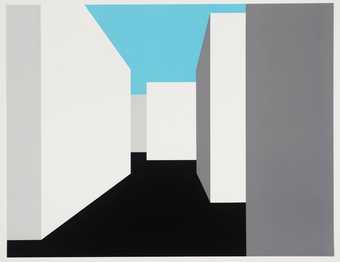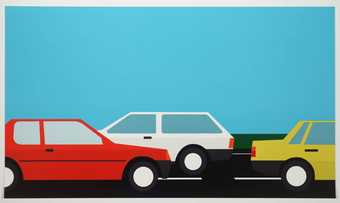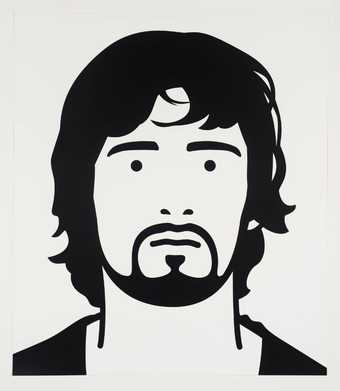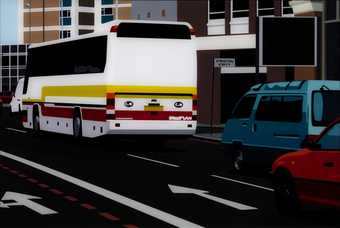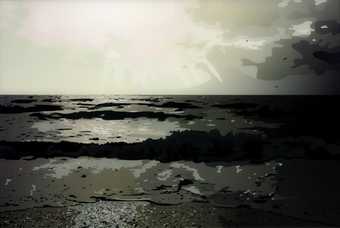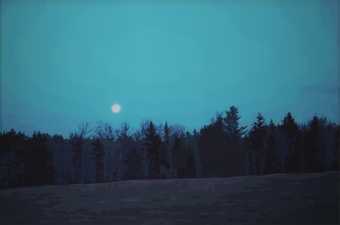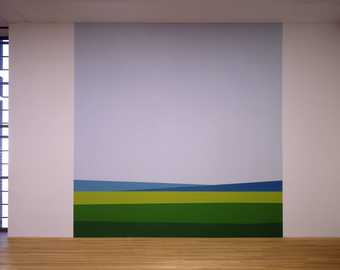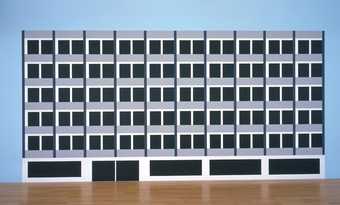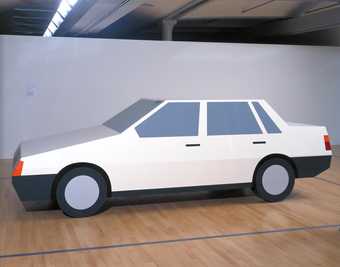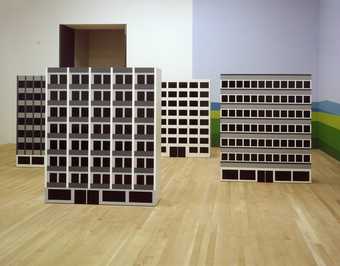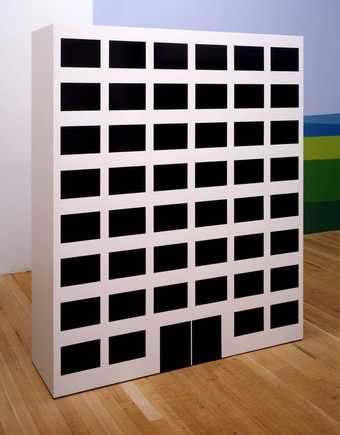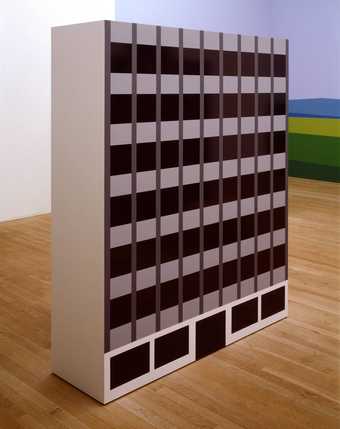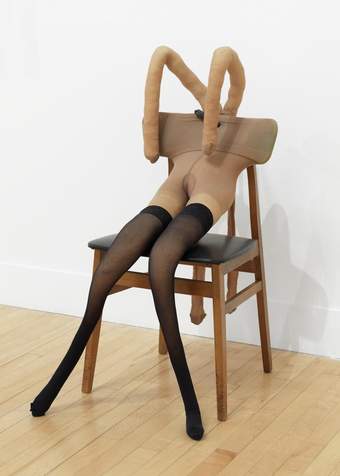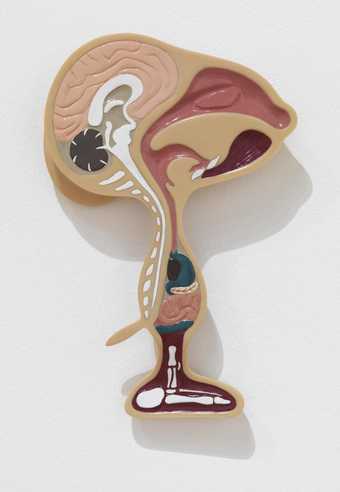
Not on display
- Artist
- Julian Opie born 1958
- Medium
- Metal and vinyl
- Dimensions
- Overall display dimensions variable
- Collection
- Tate
- Acquisition
- Presented by BALTIC, on behalf of the artist 2003
- Reference
- T07944
Summary
Escaped Animals is a series of thirteen manufactured road signs depicting animals. Each sign was produced in an edition of four plus one artist’s proof. Opie created symbols for a fox, a hedgehog, a deer, a pheasant, a goose, a cat, a sheep, a squirrel, a cow, a goat, a chicken and a dog and placed them within a circle, rectangle or triangle, depending on the animal’s form and the visual appeal of the combination. The animals are depicted as simplified outlines against a coloured ground. Some – the fox, goose, squirrel and goat - are merely outlines, their bodies the same colour as the background. Others – the deer, cat and dog - are outlined in one colour and filled in another colour. The remainder – hedgehog, rabbit, pheasant, cat, sheep and chicken - are entirely another colour. Further variation is provided by the use of coloured margins around the edge of the sign. The signs consist of two geometric sheets of aluminium covered with vinyl overlays depicting the animals. These are attached in parallel on either side of a pole which is set into the ground in a metal sleeve. The image depicted is identical on either side of the sign. Installed, they stand at varying heights in a cluster of a minimum of three (as specified by the artist). To date, most have been installed outside, although the artist has designed circular metal bases for indoor installation. Tate’s signs are the fox (yellow outline on green rectangle, white margin), hedgehog (solid black on white triangle, black margin), sheep (solid white on blue circle, white margin) and goat (white outline on red rectangle, white margin). They were installed outside Tate Modern in July 2002 as part of a nationwide project celebrating the opening of BALTIC, the Centre for Contemporary Art in Gateshead, Newcastle-upon-Tyne, who commissioned them. Groups of Escaped Animals were installed at the Arnolfini, Bristol, the Ikon Gallery, Birmingham, the Scottish National Gallery of Modern Art, Edinburgh and the Irish Museum of Modern Art, Dublin. At the same time Opie decorated the glass boxes at either end of the Gateshead Millenium Bridge with the outlines of a male and female body.
Opie’s work is based on the landscape – both urban and pastoral - of the developed world. His subjects are the elements of everyday life encountered by ordinary people living in urban and semi-urban environments and include buildings, roads, cars, trees, landscapes, cityscapes, people and domestic animals. Opie’s process involves putting everything through a unifying industrial process – that of his computer. His subjects are scanned from photographs and then simplified down to their most basic and recognisable form, creating a kind of generic language. The resulting images consisting of basic line and monotone blocks of colour, often in geometric forms, and have the homogenous appearance of institutional signage and corporate logos. Once an element – a tree, a human or an animal – has been made into a symbol, Opie exploits a range of possible uses for this element, emphasising its nature as a commodity. The same image may appear in two or three dimensions, in different materials and in a range of colours. Many of the animals depicted in the Escaped Animals
series were used in 1997 painted onto wooden blocks or cut out of wooden blocks and grouped under such titles as Hungry animals, Friendly cows and Five lost sheep. Subsequent series, intended for outdoor display, employed more industrial materials: Nine hungry animals, 2000 are made of vinyl on aluminium and Three shy animals, 2000 (displayed in Clissold Park, north London) are fluorescent lights in aluminium stands. Six lost animals, 2000 is a smaller version of the Escaped Animals using different combinations of colours and geometric forms. Another version, Eight lost animals 1, was installed inside the Ikon Gallery, Birmingham in 2001.
The latest title, Escaped Animals, implies that the animals depicted on the signs have voluntarily broken out of a restricted environment such as a cage. Some of the animals Opie has selected are part of Britain’s indigenous wildlife and usually roam freely within both rural and urban environments. Others live in closer contact with humans, usually in a peaceful symbiotic relationship with them. Like the road signs placed in rural areas to avert traffic of possible road crossing by such animals as horses, deer, ducks and frogs, Opie’s signs appear as a warning to the public. However, installed inside or next to a museum rather than on the road, the sense of warning is undermined by the incongruity of their implied presence. This is particularly true in the case of farm animals which are not likely ever to appear in or near to a museum. Translated into symbolic representations in the context of both the road and the museum, the animals are subject to an alienating process of technological co-modification, echoing the fate of all of Opie’s subjects and many elements of contemporary urban life. Whether this is good or bad, comic or tragic is left for the viewer to decide.
Further reading:
Julian Opie, exhibition catalogue, British Council 1997
Julian Opie: Sculptures Films Paintings, exhibition catalogue, Lisson Gallery, London 2001, pp.2-4
Julian Opie, exhibition catalogue, Ikon, Birmingham 2001, p.7, 16-17
Elizabeth Manchester
March 2003
Does this text contain inaccurate information or language that you feel we should improve or change? We would like to hear from you.
Explore
- abstraction(8,615)
-
- from recognisable sources(3,634)
-
- figure(2,270)
- townscapes / man-made features(21,603)
-
- signage(467)
- formal qualities(12,454)
-
- classification(114)
- diagrammatic(799)
- artifice(96)
You might like
-
Julian Opie Imagine you are walking
1998–9 -
Julian Opie Cars?
1998–9 -
Julian Opie Gary, popstar
1998–9 -
Julian Opie Siren Radio Traffic
2000 -
Julian Opie Rain Voices Surf
2000 -
Julian Opie Truck Birds Wind
2000 -
Julian Opie There are hills in the distance (c)
1996 -
Julian Opie You pass an office building. 3
1996 -
Julian Opie You are driving a Volvo
1996 -
Julian Opie You see an office building. 2
1996 -
Julian Opie You see an office building. 3
1996 -
Julian Opie You see an office building. 4
1996 -
Julian Opie You see an office building. 5
1996 -
Sarah Lucas Pauline Bunny
1997 -
David Musgrave Animal
1998

